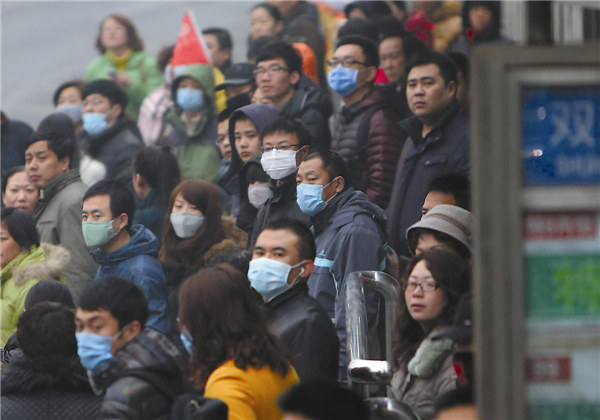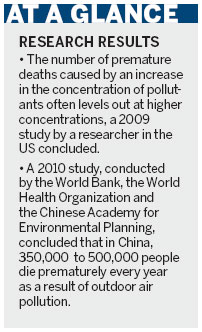 |
|
Passengers wait for buses in Beijing as smog persists in the capital on Tuesday. There is no sign of an end to air pollution that has covered many northern areas for a week. The smog prompted Beijing authorities to issue an orange warning and to urge people to stay at home. Agence France-Presse |
Among the world's best- known mega-cities, Beijing and Shanghai must be the only ones where house prices are still climbing rapidly, despite severe air pollution that will take years to solve.
But for people unhappy at becoming human vacuum cleaners in a polluted metropolis, and who are equally unwilling to forgo an urban lifestyle, which is the better choice - the capital city in the north, or the southern international trade center at the end of the Yangtze River?

During the past week, Beijing has been covered with a thick layer of smog that is forecast to persist until Thursday at least.
The smog, covering 1.43 million square kilometers mainly in northern China, prompted the Beijing government to issue an orange alert - the second-highest warning - and urge people not to leave their homes.
A study in 2013 by researchers at Tsinghua University identified more than 1,300 microbes in the atmosphere over Beijing. Although most of them may pose no direct threat to human health, the number still makes for alarming reading.
Zhuang Guoshun, director of the Center for Atmospheric Chemistry Study at Fudan University, said Beijing is covered by smog for an average of 60 percent of the year, while the figure for Shanghai is 30 to 50 percent.
However, research studies have found that higher air pollution levels do not necessarily mean higher risks of premature death or other health hazards.
One of the scientists' main concerns is the level of PM2.5 - particulate matter of 2.5 microns or smaller, which can penetrate deep into the lungs and even enter the bloodstream.
Guangzhou and Shanghai in the south of China have slightly higher relative risks to mortality from the effects of PM2.5 than Xi'an and Beijing in the north, even though the levels of PM2.5 in the northern cities were roughly twice those in the south, according to a study published in September 2013, led by Pan Xiaochuan, a professor at Peking University's School of Public Health.
Meanwhile, a recent study by the Center for Environmental Risk and Damage Assessment at the Chinese Academy for Environmental Planning concluded that even within the Beijing-Tianjin-Hebei cluster, Handan and Hengshui - two cities in Hebei province that recorded the highest number of preventable deaths during the heavy smog of January 2013 - did not have the highest levels of PM2.5 among the 12 cities in their region during the 2013 incident.
An apparent anomaly
Environmental experts and epidemiologists said there are many different reasons for the apparent anomaly, including the duration of exposure to the pollutants, local habits and customs, and economic factors.
The components and toxicity of airborne pollutants in different cities may also vary because the differing sources of pollution, according to Pan's study. He said most of the major pollutants in Xi'an are the result of coal consumption, while Beijing, Shanghai and Guangzhou have much more complex sources of pollution because of the rapidly growing number of automobiles on their roads.
|
 |
 |
 |
|
|
|
|
|
|